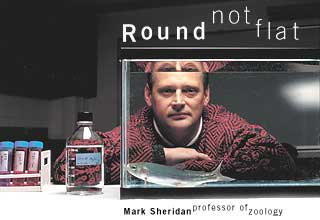
Research and creative activity are responsible for the cultural development of humankind. Innovative thinking can be motivated by necessity in order to solve a problem or by a desire to make an expression of human thought or feeling. Technological advances have marked the course of human history. For example, the wheel revolutionized transportation. Metal tools made food acquisition more efficient. The development of counting systems facilitated trade. Whether the advances were gradual or abrupt, they changed the way things were done.
Technological development and creative thought have gone hand in hand. From the use of naturally-derived pigments on petroglyphs in the caves of France or the ceiling of the Sistine Chapel to the development of fade-resistant acrylics and from the use of papyrus pulp for paper to the development of computer hardware and software, technological innovations have helped provide the media for the expression of human thoughts and feelings. Our view of the world is completely different (round not flat, and not in the center of the universe) because of innovative thinking.
Our culture continues to develop as research and creative activities proceed. New questions arise from previous answers. New ideas spring from old ones. Among the arts, new music is composed and new literature is written. Engineering principles used to build the pyramids in Giza have given way to new ones used in the design of high-speed light rail systems. In science, nothing is proven, hypotheses only are confirmed or refuted. Scientific research is a continuous process that leads to refinement of hypotheses as new findings emerge. Aquaculture, bioengineering, and gene therapy all promise to revolutionize our culture. The nature of these revolutions has ethical and political ramifications, the discussion of which also will be healthy for our culture.
Comprehensive universities like NDSU play a critical role in research and creative activities. This is because university faculty have the dual responsibility of the pursuit of scholarly endeavors as well as student instruction. The scholarly pursuits of university faculty take many forms. Some are in the form of developing disease-resistant crop varieties or the design of crop storage facilities. Others take the form of creative writing or evaluating human behaviors. Still others take the form of studying the environment or enumerable other biological processes.
What's the importance of all this research and creative activity? Simple. It provides faculty with the material to teach. Students entering a university expect and need the most current information so that they are best equipped to become innovators themselves. This steady progression of ideas, from teacher to student, has and will continue to be a driving force in our cultural development.
 The research and creative activities of university faculty help make them better teachers. Because of their scholarly pursuits, faculty are intimately familiar with the latest literature and techniques in their field. Who best to take a music literature class from and to explain the subtle nature of a fugue than from someone who has composed music? Who best to explain the nature of cell division than someone who conducts research on the regulation of the cell cycle? University faculty members dispel the old myth; in fact, they can best be characterized by those who can, teach what they do.
The research and creative activities of university faculty help make them better teachers. Because of their scholarly pursuits, faculty are intimately familiar with the latest literature and techniques in their field. Who best to take a music literature class from and to explain the subtle nature of a fugue than from someone who has composed music? Who best to explain the nature of cell division than someone who conducts research on the regulation of the cell cycle? University faculty members dispel the old myth; in fact, they can best be characterized by those who can, teach what they do.
Scholarly endeavors not only improve the classroom experience of students, but they also help provide unique hands on opportunities. In the studios and research laboratories of university faculty, students can participate in research and creative projects. These informal settings provide the best environment for mentor-based learning, where students can apply their classroom skills to real creative ventures. What better way to learn how to do science than by working in a lab, forming and testing hypotheses? Such experience improves the skill set of students and enhances their job readiness.
Research and creative activity also help engage universities with their communities. At NDSU, for example, research and extension support help to enhance agricultural production and utilization. Other research and creative activities abound in universities, from the social and behavioral sciences to science, engineering and mathematics, that have direct impact on our lives. Innovations and technologies are often transferred to the private sector. Commercialization of these ideas creates new jobs and contributes to economic development. The creative activities of the arts and humanities, which are among my favorites, take the form of the books you read as well as the art exhibits, plays and musical performances you attend.
Our lives are enriched and made better by research and creative activity. I am proud of the role that universities play in these endeavors, especially because the future of innovation is assured through our students.

































